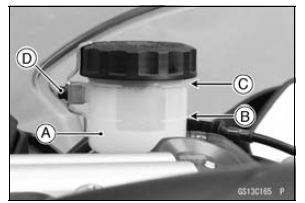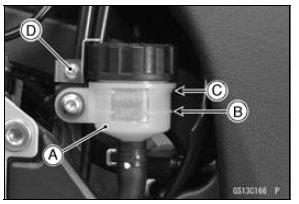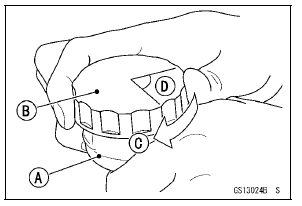


NOTE
Hold the reservoir horizontal by turning the handlebar when checking brake fluid level.
If the fluid level is lower than the lower level line, fill the reservoir to the upper level line [C].
Remove the stopper [D].
If the fluid level is lower than the lower level line, fill the reservoir to the upper level line [C].

| WARNING Mixing brands and types of brake fluid can reduce the brake system’s effectiveness and cause an accident resulting in injury or death. Do not mix two brands of brake fluid. Change the brake fluid in the brake line completely if the brake fluid must be refilled but the type and brand of the brake fluid that is already in the reservoir are unidentified. |
Recommended Disc Brake Fluid
Grade: DOT4
First, tighten the brake fluid reservoir cap [B] clockwise [C] by hand until slight resistance is felt indicating that the cap is seated on the reservoir body, then tighten the cap an additional 1/6 turn [D] while holding the brake fluid reservoir body [A].
Torque - Front Brake Reservoir Stopper Screw: 1.2 N·m (0.12 kgf·m, 11 in·lb)

 Brake Hose and Pipe Damage and Installation Condition Inspection
Brake Hose and Pipe Damage and Installation Condition Inspection Brake Pad Wear Inspection
Brake Pad Wear InspectionCrankshaft Sensor Installation
Apply a non-permanent locking agent to the crankshaft
sensor bolts [A].
Tighten:
Torque - Crankshaft Sensor Bolts: 5.9 N·m (0.60 kgf·m, 52
in·lb)
Using a high flash-point solvent, clean off any oil or dirt
that may be on the silicone sealant coating area. Dry
them with a clean cl ...
CAL and SEA-B1 Models
1. Green Hose (Purge)
2. Clamp (hold the white hose.)
3. Canister
4. White Hose (Vacuum)
5. Blue Hose (Breather)
6. Red Hose (Return)
7. Separator
8. Quick Rivet
9. Face the hook portion of the bracket to inside of the vehicle.
10. Clamp (Bend down the clamp, and hold the blue hose, the ...
Rear Master Cylinder Installation
Replace the washers that are on each side of hose fitting
with new ones.
Install the brake hose [A].
Touch the brake hose to the stopper [B] of the rear master
cylinder.
Tighten:
Torque - Brake Hose Banjo Bolt: 25 N·m (2.5 kgf·m, 18 ft·lb)
Install the master cylinder, the brack ...